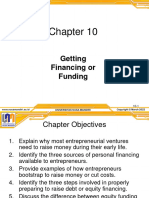0% found this document useful (0 votes)
53 views5 pagesStartup Finance
The document outlines the definition of a startup under the Startup India Scheme, emphasizing criteria such as incorporation type, turnover limits, and innovation focus. It distinguishes between startups and entrepreneurship, discusses challenges faced by startups, and details the importance of pitch decks and business models. Additionally, it covers various financing modes, including bootstrapping, angel investing, and venture capital, along with the associated risks and advantages.
Uploaded by
abithasenthiltvmCopyright
© © All Rights Reserved
We take content rights seriously. If you suspect this is your content, claim it here.
Available Formats
Download as PDF, TXT or read online on Scribd
0% found this document useful (0 votes)
53 views5 pagesStartup Finance
The document outlines the definition of a startup under the Startup India Scheme, emphasizing criteria such as incorporation type, turnover limits, and innovation focus. It distinguishes between startups and entrepreneurship, discusses challenges faced by startups, and details the importance of pitch decks and business models. Additionally, it covers various financing modes, including bootstrapping, angel investing, and venture capital, along with the associated risks and advantages.
Uploaded by
abithasenthiltvmCopyright
© © All Rights Reserved
We take content rights seriously. If you suspect this is your content, claim it here.
Available Formats
Download as PDF, TXT or read online on Scribd
/ 5



























































































